

William Stopford
BYD Shark 6 gets higher payload thanks to GVM upgrade
4 Hours Ago
Dave Humphreys gets a first drive of the new all-electric BYD Sealion 7 in Europe ahead of its Australian launch in 2025.
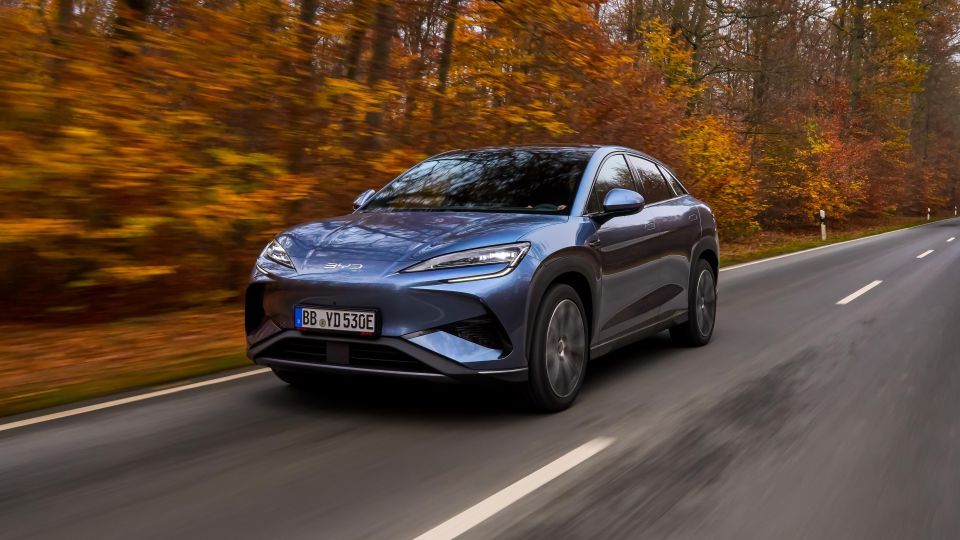


Contributor

Contributor


Contributor

Contributor
Where expert car reviews meet expert car buying – CarExpert gives you trusted advice, personalised service and real savings on your next new car.
If the BYD Sealion 6 is a bit too normal for your liking, and you’d prefer a mid-sized SUV that’s a little sportier and has an all-electric powertrain rather than a plug-in hybrid, then the Sealion 7 should be on your wish list.

As the name suggests, there’s more than a passing family resemblance between the new BYD Sealion 7 and the Sealion 6 that’s already on sale in Australia.
The Sealion 7 follows a familiar trend in the SUV segment by offering a more coupe-like profile, although the roofline doesn’t plunge as much as some others at the rear, meaning it remains rather practical inside.
There are more upmarket details to set it apart too; including large 20-inch alloy wheel options and flush-fitting door handles. For others it’ll be the 390kW output that generates interest when it arrives in Australia in February 2025.
We slipped behind the wheel of the BYD Sealion 7 in Frankfurt, Germany, giving us the opportunity to see what this all-new Chinese electric SYV – BYD’s answer to the top-selling Tesla Model Y – is like to drive in commuter traffic, on more interesting country roads and, of course, on some unrestricted autobahns.
Thus far pricing has only been confirmed for the German market in Europe, where the BYD Sealion 7 starts at €47,990 for the single-motor Comfort model.

At current conversion rates that equates to just over A$78,000, while the range-topping Excellence AWD variant’s German sticker price of €58,990 equates to almost A$96,000.
That’s considerably more than the $68,798 Australian price for the top-spec Seal sedan, which matches the Sealion 7’s performance (albeit in a different body style) and the $52,990 price of the top-spec Sealion 6 Premium dual-motor AWD PHEV.
All these prices exclude on-road costs but, BYD Australia may need to sharpen its pencils if it plans to sell it alongside the already impressive – and significantly more affordable – Sealion 6 DM-i.
Buy your new car without the stress. It's fast, simple and completely free.

Great service from Travis and team, second time I have used this business would not hesitate to recommend them to anyone
Craig C.
Purchased a Ford Ranger in Sunshine Coast, QLD
CarExpert helped Craig save $7,224 on his Ford Ranger, now let us save you on your next new car.
Get your BEST priceOwners of other BYD models will find the Sealion 7’s cabin familiar, with minor infotainment tweaks improving the user experience, but it’s the space that most will appreciate.

Up front are sports seats that are electrically adjustable on all versions – eight-way for the driver and six-way for the passenger – and upholstered in artificial leather on the base and mid-level trims, or Nappa leather for the top-spec Excellence AWD.
They are on the firm side as seats go, but they do a decent job of holding you in place, and they’re both heated and ventilated.
BYD fits a flat-bottomed multifunction steering wheel that has a four-spoke design and feels nicer than what’s used in some of its other cars. Notable changes include metallic buttons for cruise control and media features – no fiddly haptic surfaces here.
Ahead of the driver is a 10.25-inch digital instrument cluster, which is fairly standard fare in new cars these days. A colour head-up display is only available on the Excellence AWD, and it’s a basic enough setup, sticking with only the essential information a driver might need.

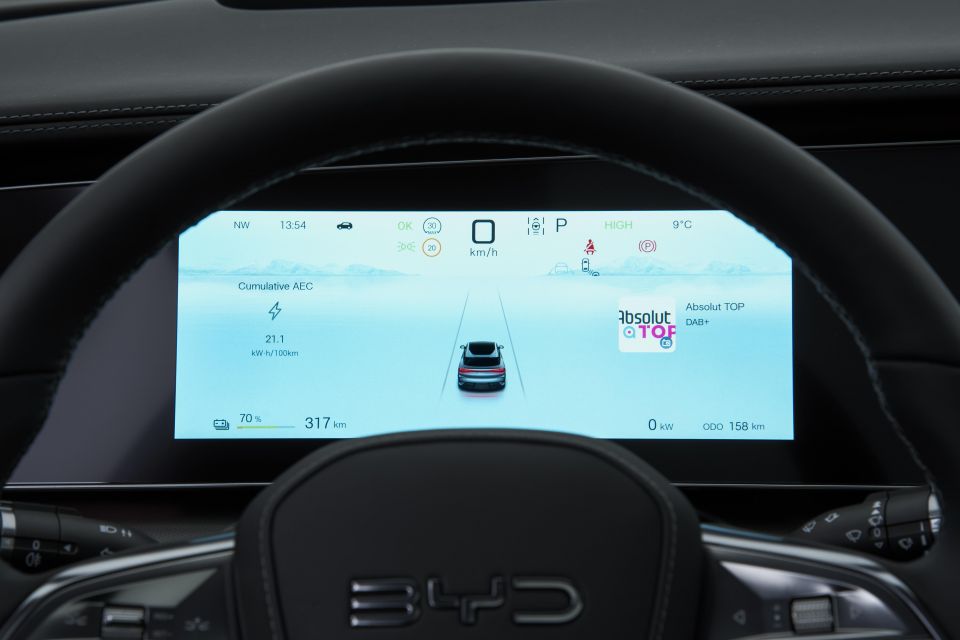


As with other BYDs, the Sealion 7 gets a sizeable 15.6-inch touchscreen infotainment system, and its party piece is that it can rotate through 90 degrees at the touch of a button, giving owners the option of landscape or portrait orientation.
The latter is a bit nicer to use for navigation purposes, but if you plan on using either Apple CarPlay or Android Auto (both available wirelessly), the screen must be in landscape mode.
BYD’s native infotainment system has come in for much-needed improvement. It’s more user-friendly now and simpler to navigate through the different menu sections.
Widgets along the base of the screen make it easier to jump between the more frequently used items, and the screen reacts very quickly to inputs.

It’s powered by a Qualcomm 8155 chip set for better performance, so don’t expect any lag, and the video game quality graphics look snazzy. Drivers can control certain functions, such as opening the tailgate, by tapping on the car on screen, and it shows the boot opening as it does. The same goes for raising or lowering windows and opening doors.
The centre console features two places for mobile phones, with one 50W wireless charging pad and a total of four USB-C ports (2x60W and 2x18W), so you’ll have no excuse for your phone running out of juice.
The stubby drive selector has a crystal look, but it’s not as tacky looking as what BMW offers in some of its cars. That’s surrounded by a few physical buttons for starting up, driving modes and volume control.
It’s even more comfortable in the rear seats, with seat backs that can be manually adjusted to provide a more relaxed angle if desired. A massive panoramic glass roof bathes the cabin in light and adds to the roomy feel. There is a retractable sun blind for it, too.


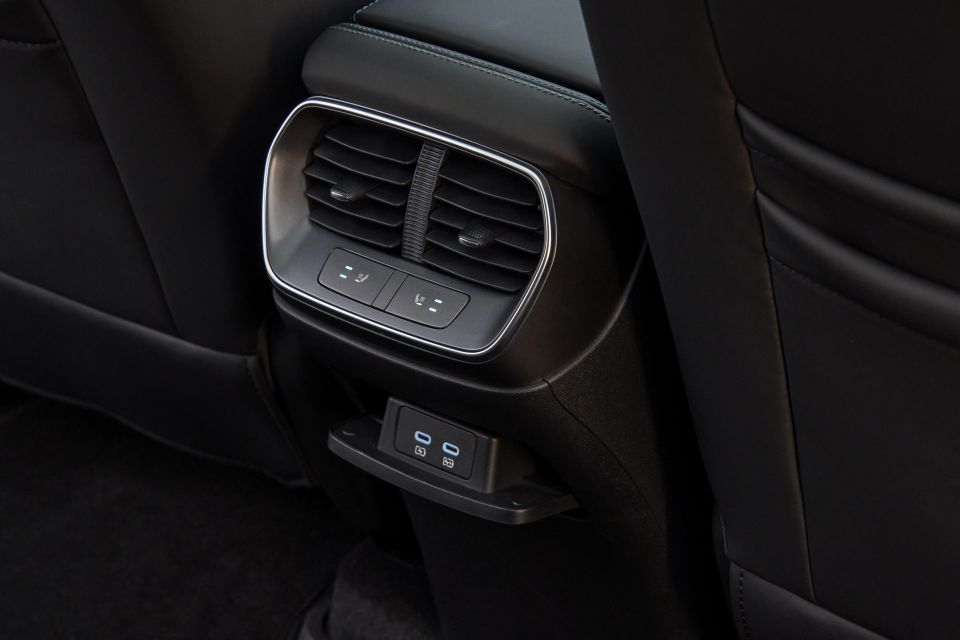

Generous amounts of headroom and kneeroom mean two tall adults will be comfortable in the back over even the longest of journeys, while even the middle seat – often a compromise – isn’t the worst by segment standards.
The rear seats get a 60:40-split and can fold down if you need more boot space.
Speaking of which, the Sealion 7 accommodates 520 litres as standard, which includes an underfloor area that’s useful for stowing charge cables.
Should you need more space, dropping the rear seats boosts capacity to 1789 litres, and there’s even a 58-litre frunk that’s shaped in a way that could carry a small case or weekend bag.
The BYD Sealion 7 comes in three different versions – but all are electric, comprising rear- or all-wheel drive, and the latter is also available with two battery options.
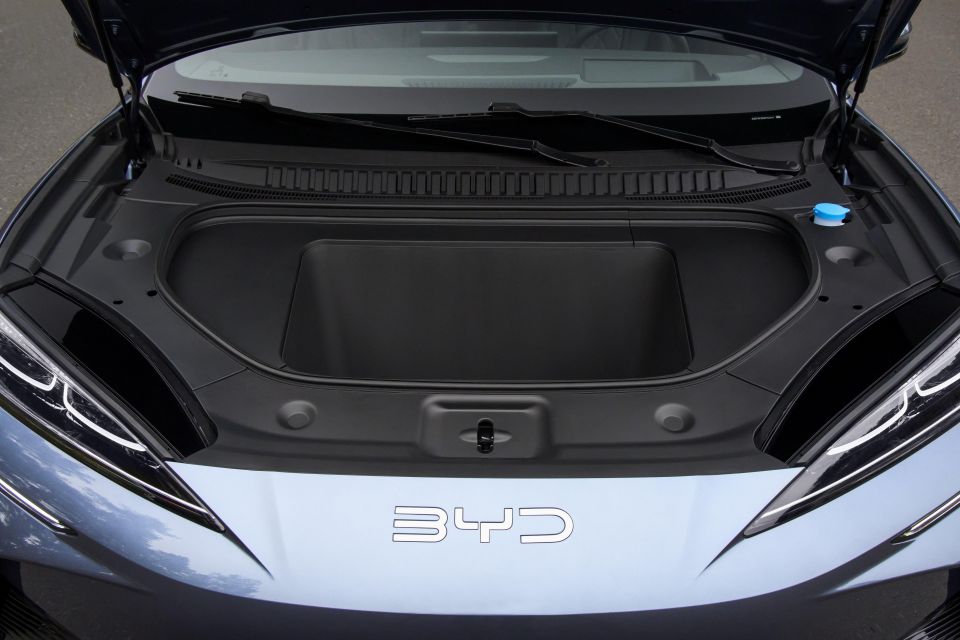
| Specifications | BYD Sealion 7 Excellence AWD |
|---|---|
| Drivetrain | Dual-motor electric |
| Battery | 91.3kWh lithium iron phosphate (LFP) |
| Power | 390kW |
| Torque | 690Nm |
| Driven wheels | All-wheel drive |
| 0-100km/h (claimed) | 4.5 seconds |
| Energy consumption (as tested) | 18.3kWh/100km |
| Claimed range – WLTP | 502 kilometres |
| Max AC charge rate | 11kW |
| Max DC charge rate | 230kW |
Even though the ‘e-Platform 3.0’ architecture it is built on is technically capable of accommodating the DM-i plug-in hybrid system, BYD has no plans to do so for the Sealion 7.
BYD uses its patented ‘Cell-to-Body’ technology in which the battery is a structural component, adding to the vehicle’s torsional stiffness while also helping to reduce overall thickness in comparison to other types of batteries.
Its Blade battery has a robust design that is resistant to the so-called Nail Penetration Test, which is used to simulate damage following a severe road traffic accident and thermal runaway.
Furthermore, the lithium iron phosphate (LFP) composition is free from cobalt and nickel, and even the starter battery is lead-free.
Right off the mark you can’t help but notice how quick the BYD Sealion 7 feels.

Officially, it takes 4.5 seconds to see 100km/h appear on the digital speedo, but in reality it feels even quicker. That’s partly down to the elevated driving position, but the other thing you notice when deploying all 390kW and 690Nm of torque is the weight.
Tipping the scales at 2435kg in this Excellence AWD trim (partly due to the large 91.3kWh battery), you do feel that mass once it gets going. The Design AWD’s 82.5kWh battery saves 95kg without sacrificing any performance.
Even so, it’s easy to overwhelm the tyres when pulling away if you’ve got a heavy right foot. The vehicle’s traction system is quick enough to intervene, but you can sense it at work.
The new electric motor operates at up to 23,000rpm, and does so without the need for a second gear ratio. Roll on the power at any speed and the pick-up in acceleration is instant, even when the car is left in the default Normal driving mode.

The speed continues to build as the numbers ratchet up, though there are few places where you can really legally use the Sealion 7’s 215km/h top speed.
All versions use fixed brake calipers with perforated front discs, and the braking performance is certainly up to scratch. So too is the amount of energy recuperation, and in urban settings it’s easy to become accustomed to driving in a manner that recuperates energy back into the battery rather than using the brakes themselves.
It’s clear that BYD’s chassis engineers have tried to give the Sealion 7 a sportier undertone, and the fitment of Frequency Variable Damping as standard contributes to that. They join a setup that comprises of double wishbones on the front axle and a multilink setup on the rear.
The general ride comfort is good, but it always feels on the firmer side, and running over more pronounced surface imperfections such as expansion joints really make a thud in the cabin.

That is made more obvious by way of how quiet the interior otherwise is when you’re on the move. BYD has paid particular attention to reducing any unwanted exterior sounds – such as road and wind noise – from seeping into the cabin.
Acoustically optimised glass contributes to what BYD claims is an average of 5dB lower interior noise compared to the competition. It is indeed quiet and generally refined inside, but possibly one of the most irritating turn signal sounds on the market does slightly detract from the experience.
Body roll remains obvious in tighter corners, though it’s generally kept well in check. There’s enough to telegraph to you what the car is doing, and that’s a good thing in an era when some more advanced electrically assisted systems try to completely stop such movements.
There isn’t a great deal of feedback or communication through the steering wheel, though it is accurate and predictable. Drivers can opt between Comfort and Sport settings for the steering, though the latter feels artificially weighted and ultimately doesn’t deliver an improvement in how the car drives.
BYD offers the Sealion 7 in three specification grades in Europe: Comfort, Design AWD and Excellence AWD.




Both AWD models get a 390kW output, but the Excellence AWD is the only version that gets the larger 91.3kWg capacity battery.
Sealion 7 highlights:
The BYD Sealion 7 has yet to be assessed by ANCAP or Euro NCAP; but going on previous results from models that share the same chassis platform and safety features, we expect it to achieve a good safety rating.

Some of the driver assistance features, particularly in Europe where speed limit warnings have become more pronounced, can be annoying as these sometimes don’t read the speed limit correctly.
Furthermore, the lane assist is what we’d describe as assertive, and some drivers might not be so keen on it. These features can be deactivated, but always default to being on when the car is started, so you would have to do so before each journey.
Standard safety equipment includes:
In Europe, the BYD Sealion 7 is covered by a six-year/150,000-kilometre vehicle warranty, an eight-year/200,000-kilometre battery warranty and an eight-year/150,000-kilometre electric motor warranty.

Where expert car reviews meet expert car buying – CarExpert gives you trusted advice, personalised service and real savings on your next new car.
| Running costs | BYD Sealion 7 |
|---|---|
| Warranty | 6 years, 150,000 kilometres |
| Battery warranty | 8 years, 200,000 kilometres |
| Roadside assistance | 1 year |
| Capped-price servicing | Up to 132 months or 220,000 kilometres |
In Australia, the standard BYD warranty differs slightly, with a six-year/150,000-kilometre vehicle warranty and an eight-year/160,000-kilometre battery warranty on its models.
The official combined WLTP range of the BYD Sealion 7 is 502km in the case of the larger 91.3kWh battery that is fitted to the Excellence AWD model.
However, if you plan on exploiting more of the car’s performance, that range figure will drop, though in average use we expect most drivers should get around 420km from it without much effort.
During our time with the car, which covered a variety of different driving scenarios, we averaged a respectable 18.3kWh/100km, beating the official figure of 21.9kWh/100km.
The single motor Comfort and dual-motor Design AWD use an 82.5kWh battery that provides combined driving ranges of 482 and 456km, respectively.
Buy your new car without the stress. It's fast, simple and completely free.

Great service from Travis and team, second time I have used this business would not hesitate to recommend them to anyone
Craig C.
Purchased a Ford Ranger in Sunshine Coast, QLD
CarExpert helped Craig save $7,224 on his Ford Ranger, now let us save you on your next new car.
Get your BEST priceWe think the Sealion 7 is a good addition to the BYD range, and with the right pricing it could do well in Australia.
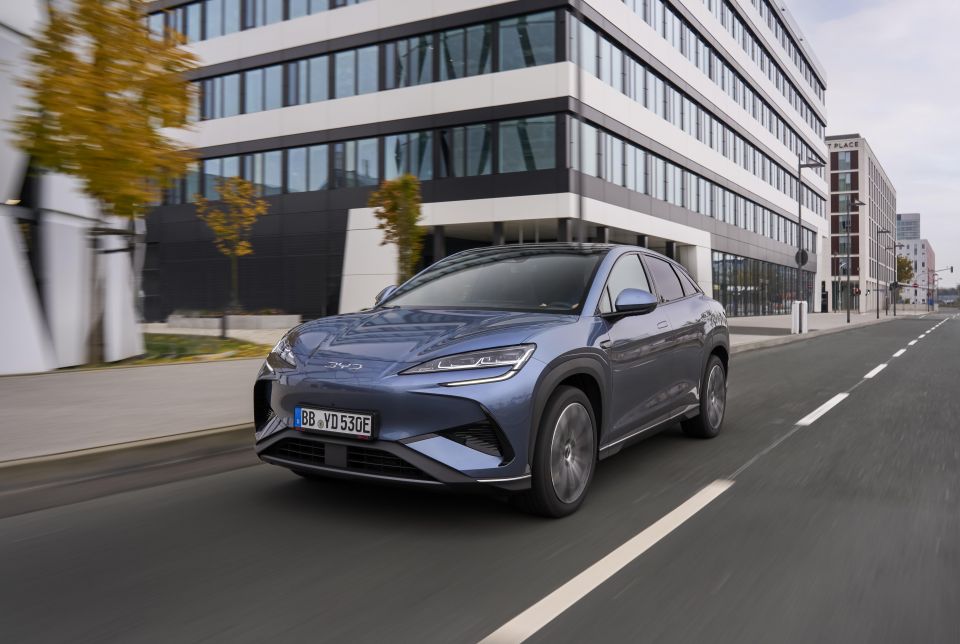
It has a design that ticks the sporty image box without compromising on the practical needs often required by SUV buyers.
On the performance front, the Sealion 7 drives keenly and is more than quick enough in its dual-motor configuration, yet it doesn’t shy away from being efficient when needed. A more affordable single-motor version will undoubtedly deliver in that respect.
With the plug-in hybrid Sealion 6 already on sale in Australia, the fully electric Sealion 7 could be the ideal addition to the lineup.

Click the images for the full gallery
MORE: Everything BYD Sealion 7
Where expert car reviews meet expert car buying – CarExpert gives you trusted advice, personalised service and real savings on your next new car.


William Stopford
4 Hours Ago


Ben Zachariah
6 Hours Ago
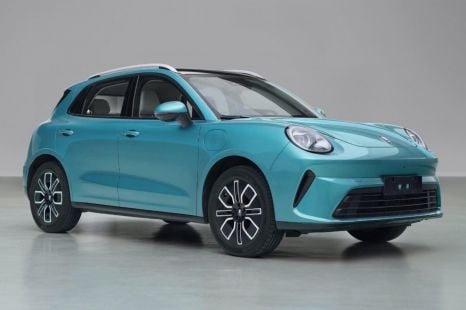

William Stopford
6 Hours Ago


Ben Zachariah
9 Hours Ago


Damion Smy
9 Hours Ago


Ben Zachariah
9 Hours Ago